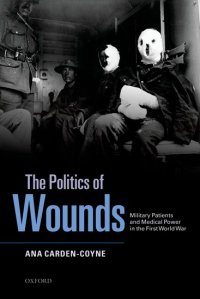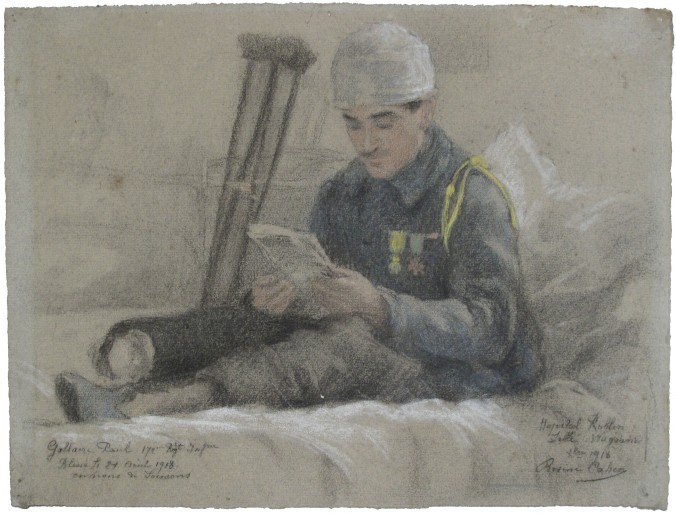For the latest contribution to our series introducing MedHumLab members, Dr Ana Carden-Coyne, Senior Lecturer in War and Conflict and Co-Director of the Centre for the Cultural History of War, talks about her understanding of medical humanities and her experience of curating the exhibitions The Sensory War at Manchester Art Gallery (2014/15) and Visions of the Front 1916-18 at Whitworth Art Gallery (until 20 November 2016).

Timothy Greenfield-Sanders, Dawn Halfaker, 2006, digital archival pigment on paper matt cotton rag © Timothy Greenfield-Sanders. This work was on view as part of the exhibition The Sensory War, Manchester Art Gallery, 11 October 2014-22 February 2015
How does your research relate to the field of medical humanities?
My recent research has been on experiences of pain among the wounded of the First World War, with a particular focus on patient and practitioner encounters. I am interested in how social relations (class and gender) bear out in those interactions of how treatments (both emergency acute and prolonged or chronic) were delivered and received.

Ana Carden-Coyne, The Politics of Wounds: Military Patients and Medical Power in the First World War, Oxford University Press, 2014
When I give talks, a lot of people end up discussing their experience in the NHS, so this is very telling about how medical humanities can have an impact on understanding and communicating our feelings about the world we live in today. We can talk about emergency procedures and triage (ambulance services or A & E, which were significantly developed in the context of WW1). We can talk about experimental surgeries and drugs, and ethical issues and patient rights. We can discuss nursing and rehab quality and care; both patients’ expectations and practitioners’ expectations, and the pressures both are often under to rapidly cure or rehabilitate the patient. We can think about the impact on families of chronic pain, when the hospitalisation ends and the family takes over. And we can look at the continuities and changes in wider social attitudes to pain and disability, and how they impact on health and wellbeing, and on medical practice itself.
My latest interest is in chronic pain suffered by wounded servicemen and women. And I am working on two projects on occupational therapy in the asylum and in military hospitals, with a major focus on men’s embroidery. I also have a new project on visual art, war and humanitarian disaster, which engages with suffering and medical intervention.
How would you define the term ‘medical humanities’ in a few sentences?
Medical humanities is an umbrella term that brings together many different arts and humanities disciplines with the medical and social sciences. What appeals to me most, is the focus on humanising medicine and enabling the patient experience through dialogue and communication, and especially through engagement with arts practitioners.
What, in your opinion, is the value of interdisciplinary research (and research networks such as MedHumLab)?
There is a great deal of inspiring work being done by creative practitioners, academics and artists who approach medicine and medical science in highly useful ways for society and for human benefit. As a historian, curator and heritage scholar, the people who work in this broad field inspire me every day.
You have curated the exhibition The Sensory War at Manchester Art Gallery (2014/15) and contributed to other exhibitions in the past. Can you tell us a bit more about your work with objects and visual material?
My research fundamentally responds to the cultural phenomena that medicine creates; whether it is diaries and memoirs, surgical technologies and devices such as prosthetics, or infections and rehabilitation treatments. For me, artists’ reactions to war medicine and surgery, and patients’ experiences of military medicine, have been one focus. But I am also interested in humanitarian medicine and its cultural field of representation. And how artists interact with the concerns of patients, cultural imagery, and big questions of human health, crisis and wellbeing.

Otto Dix, Fliehender Verwundeter, Sommeschlacht, 1916 (Wounded Man Fleeing, Battle of the Somme, 1916), from Der Krieg (The War), 1924, etching, 25.7 x 19 cm © The British Museum
The Sensory War exhibition explored how artists have communicated the impact of modern war on the mind and body, the human sensory experience, and the environment. It considered these themes in relation to each other, or what we might call, synaesthetically. It was a huge show over two floors with 247 artworks, and it took over 3 years and 3 curators to bring it to fruition. One of the sections was called ‘Rupture and Rehabilitation’. We looked at so many inspiring artists, some of whom had acted as theatre orderlies in military casualty hospitals (such as Harold Sandys Williamson’s hauntingly clinical work, The Human Sacrifice of 1918), or were commissioned to document operations during the Second World War, such as a remarkable large scale painting by Alfred Reginald Thomson, Grafting a New Eyelid (1943). Or representations of saline baths used to treat burns patients.

Rosine Cahen, Hospital Rollin (October 1918), 1918, black charcoal, pastel and white highlights on laid paper © Jean-Yves Martel
Then there were real discoveries, like the French woman artist Rosine Cahen who went around to the hospitals in France doing very intimate and immediate sketch-portraits of French soldiers recovering from severe wounds, in their beds and some wearing their medals. And we also had the extraordinary opportunity to bring to the UK for the first time The Cripples Portfolio (1919) – a set of lithographs by German artist Heinrich Hoerle – in which the daily experiences, losses and dreams of the war disabled are explored. We could compare this with Timothy Greenfield-Sanders’ large-scale glossy portraits of Iraq veterans and their prostheses, and discuss this significant twentieth-century symbol of medical modernity and the ideal of restoration from violence, yet the lingering experience of emotional pain.
I have a small exhibition that I co-curated with David Morris at the Whitworth Art Gallery at the moment, Visions of the Front 1916-18, for the Somme centenary. Medical interventions and representations are a major feature of this too, such as Henry Lamb’s painting Advanced Dressing Station on the Struma, 1916 (1921).

Henry Lamb, Advanced Dressing Station on the Struma, 1916 (1921), oil on canvas, 183.6 x 212.3 cm, Manchester City Galleries © The estate of Henry Lamb
The scene of a dressing station focuses on the relationship between a wounded man and a stretcher-bearer, who attends him with a cup of water, a great relief that many soldiers wrote about as the comfort given between men. Thirst and cold were understood much later in the war as signs of hemorrhage and shock. The bearer’s hand gently touches the wounded man’s head, providing comfort symbolic of the pietà (Christian iconography of Mary cradling Jesus’ corpse). Indeed, the pietà was often used in war-time humanitarian images of nurses caring for wounded men. But Lamb transforms the theme into an effigy of masculine care and the intimate brotherhood of shared suffering. Placed on the ledge of a shallow trench, the stretcher resembles an altar. In the right hand corner is a Thomas splint used for compound fractures, from which soldiers could die. Pathos is also created by the figure on the left, head in hand, perhaps affected by malaria, a common disease of this front, or perhaps a reference to psychological suffering. The central figure stands over the patient, staring pensively into the distance. Made three years after the end of the war, the composition of this painting symbolises the pain and succour of the entire conflict.
Henry Lamb was educated at Manchester Grammar School and studied medicine at the Manchester University Medical School. He left his studies for Paris, to attend the Académie de La Palette, where renowned modernists Jean Metzinger and Henri Le Fauconnier taught. The war compelled Lamb to finish his studies. He received a commission in the Royal Army Medical Corps and was with the Northumbrian Field Ambulance Unit in Salonika from August 1916 to March 1917.
And finally, how do you relax and unwind away from the office or seminar room?
Er… gosh… I have a toddler so it’s go go go…
Pingback: Whewell’s Gazette: Year 3, Vol. #11 | Whewell's Ghost